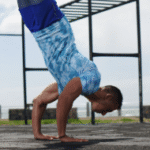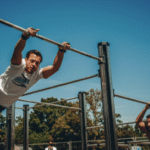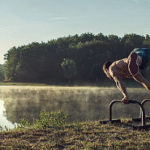Handstand conditioning exercises
Developing a strong, stable handstand requires more than just kicking up against a wall. It’s about building a solid foundation through specific conditioning exercises that strengthen the key muscle groups and improve body awareness. For anyone in Houston looking to master the handstand, incorporating these drills into your routine is essential for safe and effective progress.
- Core Strength: The Center of Your Handstand
Your core is the foundation of a handstand. Without a strong, engaged core, your body will arch, leading to instability and making it impossible to hold a straight line.
Hollow Body Hold: This is the single most important exercise for handstand conditioning. It teaches you to activate your core and maintain a rigid, neutral spine. Lie on your back, press your lower back firmly into the floor, and lift your arms, legs, head, and shoulders a few inches off the ground. Your body should form a “C” shape. Start with 15-30 second holds and gradually increase your time.
Plank Variations: Planks are a great way to build foundational core and shoulder strength. From a standard plank position, try adding shoulder taps, where you lift one hand to tap the opposite shoulder. This forces your core to work harder to maintain stability and helps you get comfortable with shifting your weight from side to side.
L-Sits: While more advanced, L-sits are a phenomenal core-strengthening exercise. From a seated position with your hands on the floor next to your hips, lift your legs and torso off the ground, forming an “L” shape. This builds the core compression needed for handstand presses.
- Shoulder Strength and Stability
Your shoulders are the primary weight-bearing joints in a handstand. You need to be able to push away from the ground and stabilize your body.
Pike Push-Ups: This is a fantastic progression that builds shoulder strength without the full weight of your body. Start in a downward-facing dog position with your hips high, resembling an inverted “V”. Lower your head toward the ground by bending your elbows and then press back up. The higher your hips, the more weight is on your shoulders.
Wall Walks: Wall walks are a powerful full-body exercise that builds endurance and confidence. Begin in a push-up position with your feet against a wall. Walk your feet up the wall as you walk your hands closer, stopping when your chest is close to the wall. This gets you used to being inverted and helps you feel the correct body alignment.
Handstand Shrugs: From a handstand position (on the wall), keep your arms straight and shrug your shoulders up toward your ears. This builds the ability to actively push through your shoulders, which is key to a solid handstand.
- Body Awareness and Alignment
A straight handstand requires you to be aware of your body in space. These drills help you find and maintain the proper alignment.
Wall Handstands (Belly-to-Wall): This is the best way to practice a straight handstand line. Face a wall and walk your hands toward it as you walk your feet up until your body is in a straight line, with your stomach facing the wall. This position prevents you from arching your back and forces you to engage your core and glutes.
Wrist Drills: Your wrists are under a lot of stress during handstands. Warm them up with wrist circles, wrist extensions, and wrist push-ups on all fours. To build strength, you can also practice “gripping” the floor with your fingers to engage your forearms.
Pro-Tips for Your Conditioning Routine
Consistency is Key: Aim to train 3-4 times per week, with sessions lasting 15-20 minutes. Consistency will yield better results than long, infrequent sessions.
Prioritize Form: Always focus on proper technique over speed or number of repetitions. Incorrect form can lead to injury and build bad habits that are hard to correct later.
Listen to Your Body: Handstand conditioning is demanding. If you feel pain in your wrists or shoulders, stop and rest. It’s better to take a break than to get injured.
Find a Coach: If you’re in Houston, consider finding a local calisthenics gym or a gymnastics studio that offers handstand classes. A coach can provide personalized feedback and a structured program to help you progress safely.

Handstand conditioning exercises
Route
Calisthenics Gym Houston Functional Bodyweight Training
Secondary phone: (346) 483-3195
Email: info@calisthenicsclubhouston.com
URL: https://calisthenicsclubhouston.com/
Monday 6:00 AM - 7:00 PM Tuesday 6:00 AM - 7:00 PM Wednesday 6:00 AM - 7:00 PM Thursday 6:00 AM - 7:00 PM Friday 12:00 PM - 6:30 PM Saturday 9:45 AM - 12:00 PM Sunday 3:00 PM - 5:00 PM





